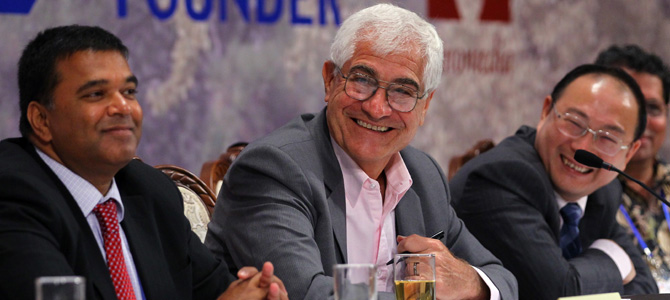
BEIJING -- Whoever sees the half-year report on China's economy, whether they be policymakers or economists, would not view the figures as a glowing result for the world's second-largest economy.
Gross domestic product in China expanded 7.6 percent year-on-year in the second quarter, easing below 8 percent for the first time in three years and marking the sixth quarterly decline in a row, according to the National Bureau of Statistics.
The GDP data in the second quarter took Chinese economic growth in the first six months to 7.8 percent year-on-year, which still surpassed the government target of 7.5 percent for the full year.
To some analysts, the slowest growth pace in three years showed China is facing increased risks of a hard landing.
But Sheng Laiyun, the spokesman for the National Bureau of Statistics, said the 7.6-percent rate was "a fairly good speed" compared with other major world economies, and he was "full of confidence" about the prospects of China's economy.
Optimists consider the Chinese economy bottomed out in the second quarter, but the country still needs to continue reforms to solve problems that make its current development pattern unbalanced, uncoordinated and unsustainable.
"China must ensure its GDP growth does not to drop below 7 percent, otherwise high unemployment and other deeply-rooted social problems will emerge," said Wei Jie, a professor at Tsinghua University School of Economics and Management.
However, Wei himself opposed any massive stimulus such as the size of the 4 trillion yuan ($634.92 billion) in 2009 to stabilize growth in the world's second-largest economy since the bailout of the economy through massive stimulus "will only postpone problems and miss the opportunity to restructure the Chinese economy".
Responding to the current economic slowdown, the State Council, or the central government, adopted new measures encouraging private companies to invest in sectors such as banking, energy and transport - which are currently dominated by State-owned companies.
The People's Bank of China, the central bank, even announced a surprise rate cuts twice in a month, slashing the banks' benchmark one-year borrowing and lending rates by 50 and 56 basis points, respectively.
Pan Xiangdong, chief economist with Galaxy Securities, said the slowing GDP growth has outweighed inflation as the top concern for Chinese policymakers.
To stabilize growth in the short term, Pan said, China needs to rely on investment again, as exports are easily affected by the sluggish external demand while a significant increase in consumption will take time.
Investment, exports and consumption are the three major drivers of growth in the Chinese economy. According to the NBS data, investment accounted for about two-thirds of China's GDP in the first half of this year.
Pan said China needs to speed up reforms in the transfer of land use rights, the resident registration system as well as systems concerning pension, insurance and education that check the country from rapid economic growth.
"What we are concerned about is the possible overreaction from policymakers," said Li Daokui, a former monetary policy adviser to the PBOC.
Li said the existing measures aimed at maintaining growth are enough to help China achieve a U-type rebound this year.
Since 2008, China's macroeconomic policies have shifted between stimulus and tightening several times, indicating the difficulty for economic restructuring in the world's second-largest economy, which used to rely heavily on government spending, the property sector and labor-intensive exporting industries for rapid growth.
But the lingering European sovereign debt crisis and a fragile US economic recovery have significantly brought down external demand for Chinese goods and services this year, while an ageing population and rising labor costs at home also slackened the process of China's "transformation of economic growth pattern".
"The Chinese economy needs to increase is its effectiveness, rather than just the size," said Cao Yuanzheng, chief economist with the Bank of China. "What matters is whether China can successfully restructure its economy and make it more effective and of better quality."
Wu Xiaoqiu, president of the Financial and Securities Institute of Renmin University of China, said China has to get used to slower growth as China shifts itself from an investment-driven economy to a consumption-driven one.
"China will see its growth ease to 7-8 percent by 2020 and slow further to around 5 percent after 2020," Wu said.
Even though their minds may vary on the short-term economic outlook, many Chinese economists are pressing policymakers to accelerate reforms to eliminate the problems troubling the world's second-largest economy.
"In a time of stalling domestic and external demands, I can understand why the government has resorted to investment for short-term growth again. But reforms are important," said Liang Youcai, chief economist of China Economic Information Network.
"Of all structural unbalance, the income distribution is the most outstanding, thus we need to speed up reforms in this regard and break monopoly and reduce restriction to promote the long-term development of the economy," he added.


 Washington to remain focused on Asia-Pacific
Washington to remain focused on Asia-Pacific RQFII target blue chips amid bear market
RQFII target blue chips amid bear market Australian recall for top two exporters
Australian recall for top two exporters China fears new car restrictions
China fears new car restrictions